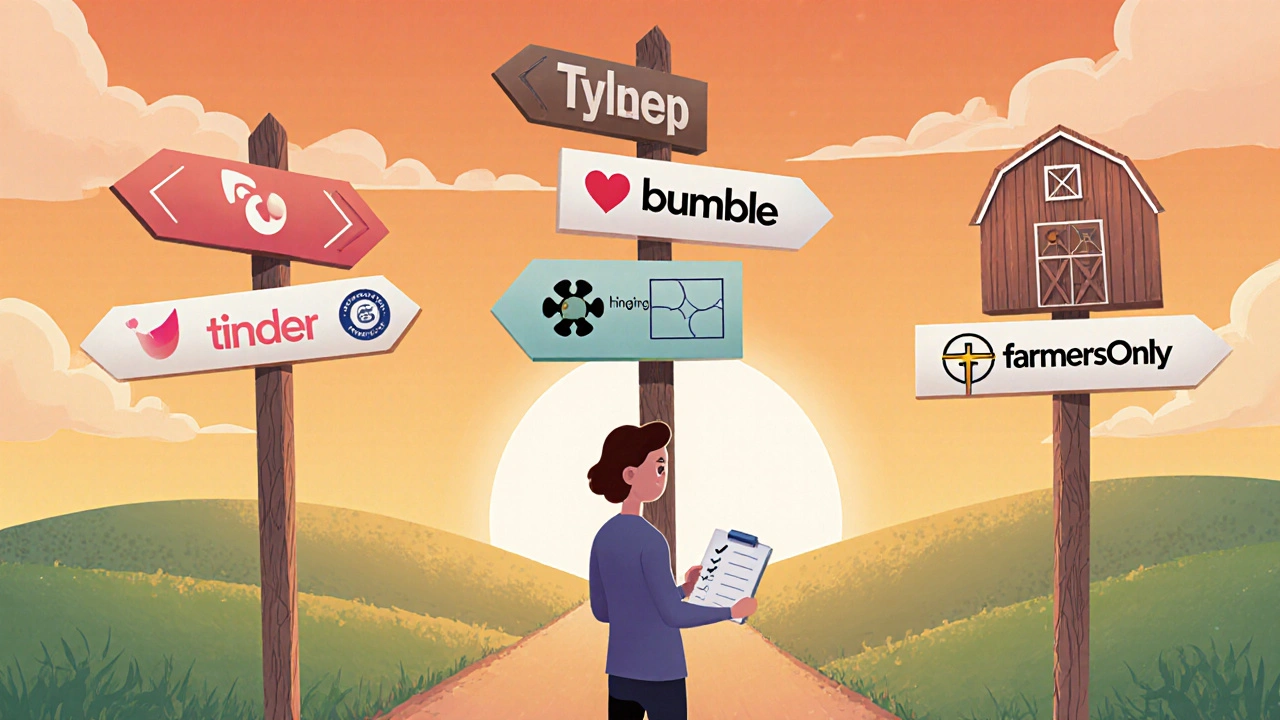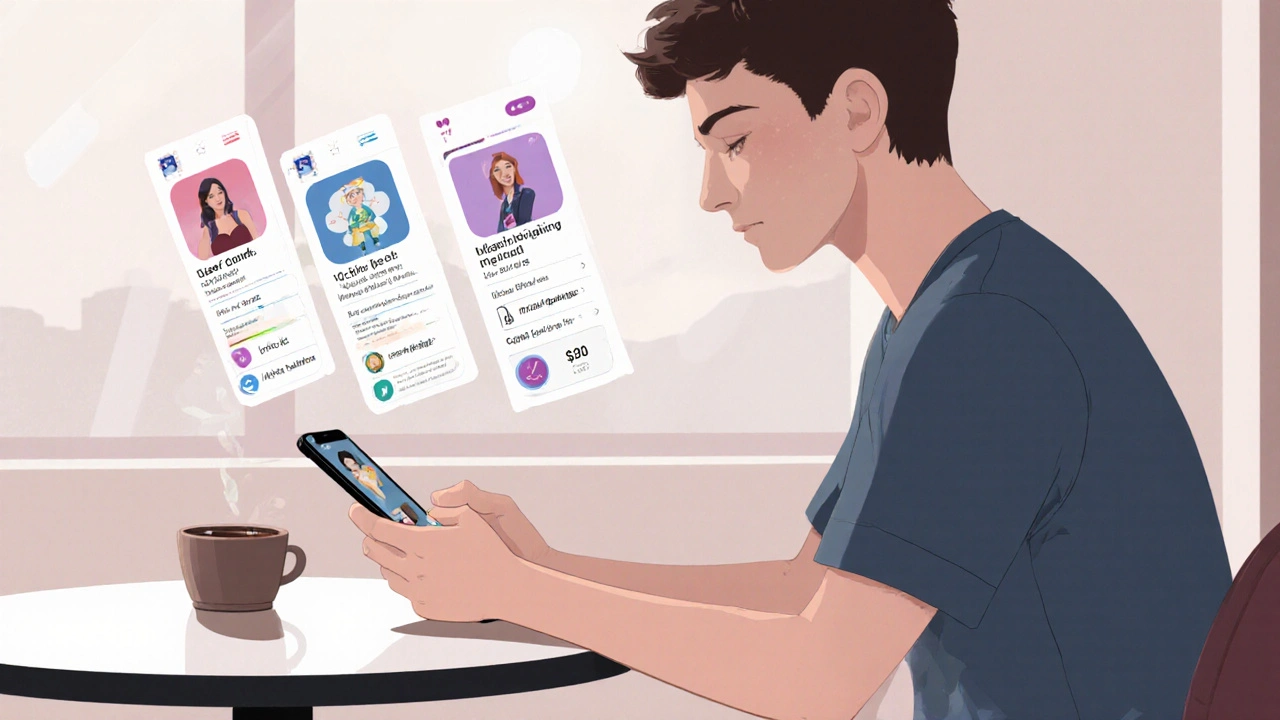Dating Site Selector
Find the best online dating platform for your specific needs and priorities. Answer a few questions and get personalized recommendations based on your relationship goals, budget, and preferred features.
Select the features most important to your safety and security:
Finding a partner online feels a lot like shopping for a new phone - you have to know what matters to you, compare the specs, and read the fine print before you swipe. The good news is that the market for online dating site options is richer than ever, ranging from massive global platforms to tiny niche communities. Below is a step‑by‑step guide that helps you cut through the hype and pick the service that actually fits your life.
Quick Takeaways
- Define your dating goal (casual, serious, niche interest) before you start browsing.
- Check the matchmaking method - algorithms, human matchmakers, or hybrid.
- Look at user demographics: age, gender balance, and location density.
- Prioritize safety features like photo verification, AI‑driven fraud detection, and clear reporting tools.
- Compare pricing structures; many sites offer free tiers but the best matches usually require a paid plan.
1. Pin Down Your Dating Goal
Every dating platform is built around a core promise. Some aim for long‑term relationships, others focus on quick, low‑commitment flings, and a growing few cater to very specific interests (e.g., gamers, vegans, or seniors). Write down the top three outcomes you want from a relationship. This short list will be your North Star when you start evaluating options.
For example, if you’re looking for a partner who shares your love of outdoor adventures, a niche site that highlights interests in hiking or kayaking will surface more relevant matches than a generic app where “outdoor activities” is just another checkbox.
2. Understand the Matchmaking Approach
When you read a site’s marketing copy, you’ll often see buzzwords like “AI‑powered” or “human‑curated.” Here’s what each really means:
- Matchmaking algorithm is a set of mathematical rules that compare user profiles, activity patterns, and stated preferences to suggest compatible partners. Algorithms can be simple (based on age and distance) or complex (using machine‑learning to weigh dozens of factors).
- Human matchmaker service involves real people reviewing profiles and making introductions. This approach is common on premium niche sites and often yields higher-quality matches, albeit at a higher price.
- A hybrid model mixes both, using an algorithm for the first pass and human reviewers to fine‑tune suggestions.
Ask yourself how much control you want. If you enjoy tweaking preferences and reading data, an algorithm‑first site may feel empowering. If you prefer a personal touch, look for services that advertise “human‑assisted matching.”
3. Check the User Base
The size of a platform matters, but so does its composition. A site with millions of users can feel overwhelming, while a small community may lack enough viable matches.
Key metrics to investigate:
- Active user count - the number of members who log in at least once a week. Platforms often publish this figure in press releases.
- Gender ratio - a balanced ratio (close to 1:1) reduces the wait time for a match.
- Age distribution - make sure the majority of users fall within your target age range.
- Geographic concentration - some sites are stronger in North America, others dominate Europe or Asia.
Many platforms publish demographic breakdowns in their FAQ or press kit. If the data isn’t public, you can get a sense from community forums or by signing up for a free trial.

4. Prioritize Safety and Verification
Online dating carries risks, but reputable sites invest heavily in protecting members. Look for the following safety features:
- Photo verification - users are asked to take a real‑time selfie that the system matches to their profile pictures.
- AI fraud detection - algorithms that flag suspicious messaging patterns or duplicate accounts.
- Report and block tools - easy‑to‑access buttons that let you flag abusive behavior instantly.
- Transparent privacy policy - the site should explain how it stores data, who can see it, and how long it retains it.
Test the process yourself: try reporting a dummy profile and see how quickly the team responds. A site that treats safety as a feature, not an afterthought, will usually have a dedicated support team and clear escalation paths.
5. Compare Pricing & Subscription Models
Most dating platforms operate on a freemium model: you can create a profile for free, but key actions (sending messages, seeing who liked you) require a paid plan.
Important pricing considerations:
- Subscription tiers - basic, premium, and elite levels often differ in visibility, boost options, and access to advanced filters.
- Refund policy - reputable sites offer a 7‑day money‑back guarantee if you’re unsatisfied.
- Hidden costs - some platforms charge extra for “super likes,” profile boosts, or read‑receipts.
Do the math: if a premium plan costs $29.99 per month but gives you unlimited messaging and advanced matchmaking, that may be worth it compared to a $9.99 basic plan that limits you to ten messages a day.
6. Mobile Experience and App Quality
Most people browse dating sites on their phones, so the mobile app is a make‑or‑break factor.
- App performance - smooth scrolling, quick load times, and low crash rates indicate a well‑maintained product.
- Push notifications - useful for real‑time match alerts but not intrusive.
- Feature parity - ensure the app offers the same filters and safety tools as the web version.
Read recent user reviews on the App Store or Google Play. A steady stream of updates (at least once a month) shows the developers are actively improving the experience.
7. Niche vs. Mainstream - Which Fits You?
Large mainstream sites (e.g., Tinder, Bumble) provide massive pools but can feel generic. Niche sites (e.g., Hinge for serious dating, ChristianMingle for faith‑based matches, or FarmersOnly for rural lifestyles) offer curated communities.
Pros of niche platforms:
- Higher likelihood of shared values or hobbies.
- Less competition for attention - fewer users sending generic messages.
- Tailored onboarding questions that improve match relevance.
Cons:
- Smaller user base, which can mean longer waiting times in less‑populated regions.
- Often higher subscription costs because the service is more specialized.
Use your goal list from Section1 to decide. If you’re open‑ended and live in a big city, a mainstream site may work best. If you have a strong identity marker (e.g., religion, profession), a niche platform can accelerate finding a compatible partner.

8. Decision Checklist
- Write down your top three relationship goals.
- Identify the matchmaking style you prefer - algorithm, human, or hybrid.
- Check active user numbers, gender ratio, and age distribution for your locale.
- Verify safety tools: photo verification, AI fraud detection, clear reporting.
- Compare subscription costs and refund policies.
- Test the mobile app for speed, UI clarity, and feature parity.
- Decide between niche and mainstream based on shared interests vs. pool size.
After you’ve ticked each box, you’ll have a shortlist of 2‑3 platforms. Sign up for a free month or use a trial period, then evaluate the quality of matches you receive. If the conversations feel surface‑level after two weeks, it’s probably time to switch.
Comparison Table: Key Factors Across Popular Platforms
| Platform | Primary Matchmaking | Active Users (US) | Safety Tools | Price (Premium Monthly) | Best For |
|---|---|---|---|---|---|
| Tinder | Algorithm + Swipe UI | 6.5M | Photo verification, AI fraud alerts | $19.99 | Casual, young adults |
| Bumble | Algorithm with women‑first messaging | 4.2M | Live photo verification, 24/7 support | $18.99 | Professional, gender‑balanced |
| Hinge | Algorithm + detailed prompts | 3.1M | Photo verification, AI‑driven abuse detection | $23.99 | Serious dating, mid‑30s |
| eHarmony | Human‑curated compatibility test | 1.8M | Verified ID, manual review of reports | $29.99 | Long‑term relationships |
| FarmersOnly | Algorithm + lifestyle filters | 0.4M | Photo verification, community moderators | $21.99 | Rural, niche interests |
Next Steps & Troubleshooting
If you’ve landed on a platform that feels promising but aren’t getting matches, try these quick fixes:
- Refresh your profile photos - clear, well‑lit images boost visibility.
- Update your bio with specific hobbies; generic statements like “I love music” tend to get ignored.
- Adjust your distance and age filters to widen the pool.
- Use “boost” features during peak hours (typically evenings on weekdays).
Still stuck? Reach out to the site’s support team. Reputable services will answer within 24hours and may offer a temporary free upgrade if technical glitches are causing missed matches.
Frequently Asked Questions
How can I tell if a dating site’s algorithm is trustworthy?
Look for transparency reports that explain what data points the algorithm uses (e.g., interests, communication style). Sites that publish research papers or partner with academic institutions usually have more robust, unbiased models. Also, test the system by liking a diverse set of profiles and see if the suggested matches improve over time.
Are paid subscriptions worth it?
Paid plans unlock features that directly affect match quality: unlimited messaging, profile boosts, and access to advanced filters. Most users report a higher response rate after upgrading. If you’re serious about finding a partner, the modest monthly cost often pays off in saved time and better matches.
What safety red flags should I watch for?
Beware of profiles with only one photo, overly generic bios, or requests to move the conversation to external apps quickly. Honest sites provide in‑app video chat or voice verification before you share personal contact info.
How do niche dating sites compare to big platforms?
Niche sites focus on shared values or lifestyles, which can cut down on the time spent filtering out incompatible matches. However, they often have fewer members in smaller towns, so you may need to broaden your radius or be patient for new sign‑ups.
Can I try a site before paying?
Most platforms offer a free tier that lets you set up a profile and browse matches. Premium features are usually locked, but many provide a 7‑day money‑back guarantee if you upgrade and decide it’s not for you.


Written by Michele Bradford
View all posts by: Michele Bradford